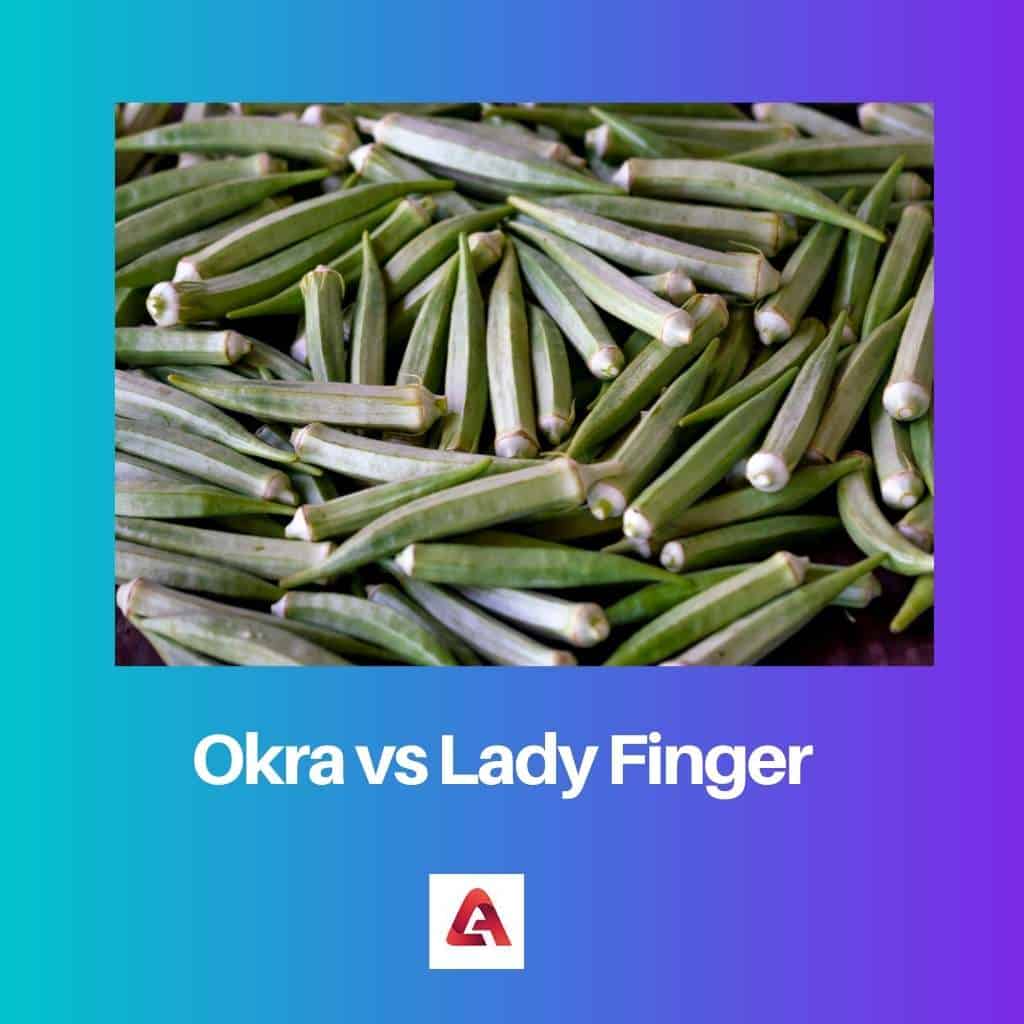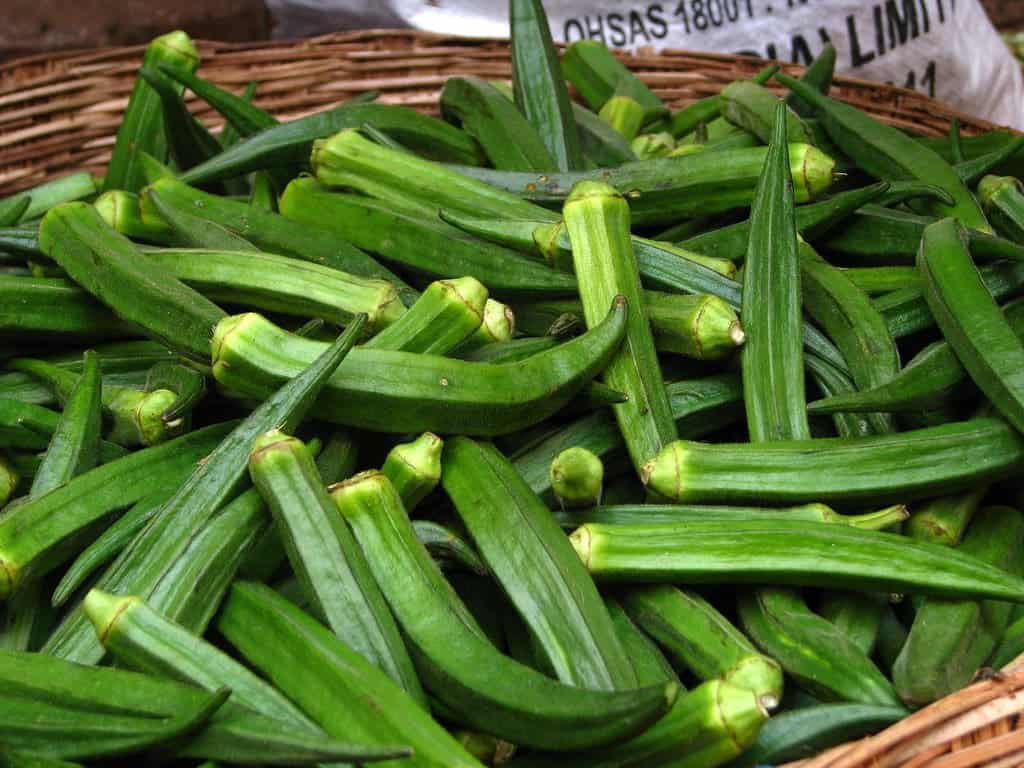The World has several Countries where the traditions, names and cultures differ from each other. The names of the vegetables vary from country to country.
However, the English terms of the vegetables are the same, but some are different in various countries. Okra and Lady Finger are named vegetable plants are grown in several countries.
Key Takeaways
- Okra is the plant’s name, while lady finger refers to the edible green seed pod.
- Both terms can be used interchangeably to describe the same vegetable.
- Okra, or lady finger, is popular in Southern American and Indian cuisines.
Okra vs Lady Finger
The terms “okra” and “lady finger” both refer to the same vegetable, which is a green, elongated pod that is commonly used in cooking. The name “lady finger” is more commonly used in the Indian subcontinent. “Okra” is more commonly used in the Western world.

Okra is a name for vegetables that are grown in many countries. The scientific name of the Okra is Abelmoschus Esculentus and, Okara had also spelt as Okro.
The label Okra had been called in the Philippines and the United States throughout the World. The shells of the Okra are strong and decorously shaped.
The Okra will cultivate in every season and available in all seasons.
In Contrast, Lady Finger is a plant name that helps to grow the vegetable. Abelmoschus Esculentus is a scientific name for the Lady Finger and, it belongs to the Mallow family.
Lady Finger is an English name, that countries like British, India and some others pronounce. The other label of the Lady Finger is Okra.
Except for the US and the Philippines, the maximum countries use the term Lady Finger.
Comparison Table
| Parameters of Comparison | Okra | Lady Finger |
|---|---|---|
| Definition | Okra is the name of the vegetable plant grown in many countries. | Lady Finger is a vegetable that is grown in all seasons. |
| Family | Okra belongs to the Mallow family. | Lady Finger is a member of the Mallow Family. |
| Difference | Okra had pronounced in US and Philippines. | All the English countries except the US and Philippines pronounce as Lady Finger. |
| Countries | Malaysia, Turkey, Saudi Arabia, England, Norway, Philippines countries pronounce the term Okra. | Nepal, Sri Lanka, India, Bangladesh, Maldives, Bhutan, Tibet and some other countries call Lady Fingers. |
| Taste | Okra consists of various nutrients, minerals and proteins, where an individual can have a good and spicy taste. | Ladies Finger contain proteins as Okra and consist of Vitamin D, where both are similar. |
What is Okra?
Okra is a name for vegetables that are grown in many countries. Okra is good for health because it provides many nutrients and proteins to the individual body.
Okra originated in Ethiopia from the Abyssinian centre. This vegetable crop taken by the Egyptians belongs to the East region.
The seventh-century conquered king in East Egypt took the Okra crop. The scientific name of the Okra is Abelmoschus Esculentus and, Okara had also spelt as Okro.
The label Okra had been called in the Philippines and the United States throughout the globe. The shells of the Okra are strong and decorously shaped.
The Okra will cultivate in every season and available in all seasons. Okra belongs to the mallow family, where the plant looks like hibiscus flowers.
The okra crop did not have any seasonal reasons to cultivate and the farmers can crop every season. The name Okra will call in only some countries whereas other countries used to pronounce it with an English name.
The taste of the Okra is sweet and grassy, and it takes time to cook. An individual can find dishes of Okra in Crispy, Dense and Creamy.
It can cook as soup, fried and in various ways by adding ingredients. After cropping, the leaves will bloom in a single day, where the pods will harvest and then pollinate to get the Okra vegetable.
By eating this, individual minds can become sharp and, the memory power will increase to remember things. This plant can cultivate in soils and grow with space up to 12-18 inches.
The Okra will take 2-12 days to fatten in the soil. People can harvest the Okra plant in the backyards of the house. Okra contains Vitamin A, Vitamin C, Vitamin B6 and Vitamin K, which is rich in Vitamins C and A.
Okra also consists of antioxidants which avoid the diseases like heart stroke, diabetes, cancer and strokes.

What is Lady Finger?
Lady Finger is a kind of vegetable plant that grows in various places. The scientific name of the Lady Finger is Abelmoschus Esculentus and, it belongs to Mallow Family and Hibiscus Family.
The vegetable takes the shape of a hibiscus flower and the inside pods are very strapping. Lady’s finger is an English name, whereas some countries like to pronounce it.
The Ladies Finger appears in green and, the pods are in white. It is creamy when an individual touch it.
Usually, Lady Finger had known as okra, where Lady Finger is an English name. The label Lady Finger originated from the Duchy of Savoy, where they prepare the biscuits.
After the king of France in the 15th century labelled as Savoiardi to the Lady Finger biscuits, the Lady Finger became the raw vegetable name.
The Lady Finger crop did not have any seasonal reasons to cultivate and the farmers can crop every season. The name Lady Finger is called in only some countries whereas the other countries used to pronounce it by another name.
Lady Finger is a healthy vegetable where it is helpful in indigestion. It is rich in fibre and avoids constipation problems with the help of laxative properties.
The antioxidants in the Lady Finger help to protect the liver and save it from damage. An individual who takes the Lady Finger daily can avoid cholesterol issues and heart problems.
Nepal, Sri Lanka, India, Bangladesh, Maldives, Bhutan, Tibet, Afghanistan and Maldives countries label the English name Lady Finger. An individual can find the dishes of Lad Finger Crispy, Dense and Creamy.
The Lady Finger flower blooms in 2-3 months after seeding, where the pods had taken place after flowering. It can grow up to 3 to 5 inches after pods appear.
Lady Finger consists of 33 calories and proteins like Calcium, Magnesium, and Iron. It carries Vitamin C, Vitamin D and Vitamin B6, which helps the human body to survive.
Vitamin D and Vitamin B6 help Vitamin D and Vitamin B6, which assist humans.

Main Differences Between Okra and Lady Finger
- Okra takes a day to bloom a flower, whereas Lady Finder takes months after seeding.
- Okra is the name of the vegetable plant grown in many countries, whereas Lady Finger is a vegetable grown in all seasons.
- Okra contains Vitamin A and C, whereas Lady Finger consists of Vitamin D and Vitamin C.
- Both Okra and Lady Finger are the same, but the pronouncing countries are different.
- Okra had pronounced in US and Philippines where All English countries except the US and the Philippines pronounce it as Lady Finger.


The health benefits of Okra and Lady Finger are well explained. It’s impressive to see how these vegetables are not only delicious but also packed with essential vitamins and nutrients.
The historical context provided for the names of these vegetables is very insightful.
This article made me appreciate the cultural differences in naming vegetables. It’s quite fascinating.
The detailed comparison between Okra and Lady Finger is fascinating, especially the history behind the names of these vegetables. It’s interesting to see how different cultures and countries have influenced the naming of these vegetables.
Indeed, the cultural and historical significance of these names adds a layer of complexity to something as seemingly simple as vegetables. It’s a testament to the diversity of the world we live in.
This article provides a very accurate and detailed comparison between okra and lady finger, it’s very informative!
This article provides a comprehensive overview of the differences between Okra and Lady Finger. It’s a great resource for anyone interested in the culinary or botanical aspects of these vegetables.
It’s interesting to see how the names of vegetables can vary so much from country to country. Great insight.
What’s in a name? A lot, apparently. Informative read, indeed.
The culinary uses and nutritional value of Okra and Lady Finger are intriguing. It’s fascinating to learn about the diverse ways in which these vegetables are used in different cuisines around the world.
I found the nutritional information about both okra and lady finger very enlightening.
The in-depth exploration of the cultural, botanical, and nutritional aspects of Okra and Lady Finger is impressive. It truly highlights the depth of knowledge surrounding these seemingly everyday vegetables.
I find it amusing how two different names can be used for the same vegetable in different parts of the world. It’s a testament to the diversity and complexity of language and culture.
Absolutely, the level of detail in this article is commendable. It sheds light on the cultural and culinary significance of Okra and Lady Finger in a way that’s both informative and engaging.
The extensive information about the cultivation and nutritional content of Okra and Lady Finger is quite enlightening. It’s clear that these vegetables have a rich history and global significance.